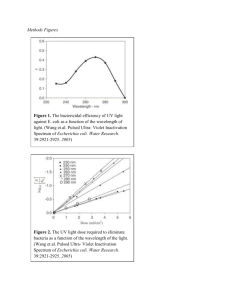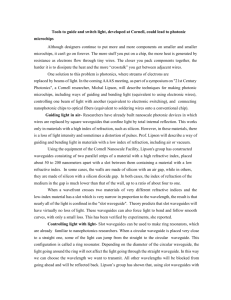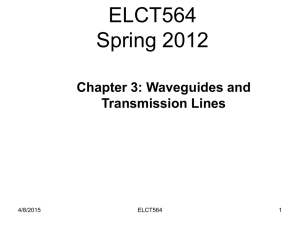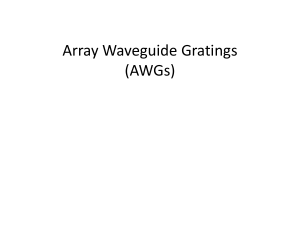Demonstrating the style for the Journal of Physics
advertisement
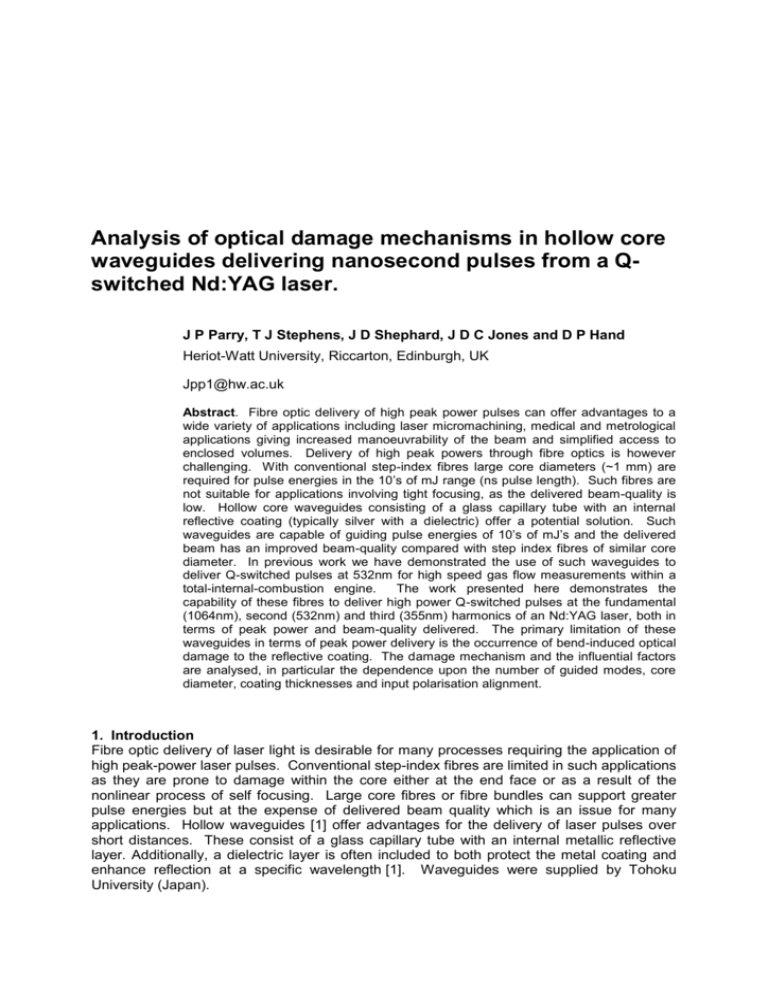
Analysis of optical damage mechanisms in hollow core waveguides delivering nanosecond pulses from a Qswitched Nd:YAG laser. J P Parry, T J Stephens, J D Shephard, J D C Jones and D P Hand Heriot-Watt University, Riccarton, Edinburgh, UK Jpp1@hw.ac.uk Abstract. Fibre optic delivery of high peak power pulses can offer advantages to a wide variety of applications including laser micromachining, medical and metrological applications giving increased manoeuvrability of the beam and simplified access to enclosed volumes. Delivery of high peak powers through fibre optics is however challenging. With conventional step-index fibres large core diameters (~1 mm) are required for pulse energies in the 10’s of mJ range (ns pulse length). Such fibres are not suitable for applications involving tight focusing, as the delivered beam-quality is low. Hollow core waveguides consisting of a glass capillary tube with an internal reflective coating (typically silver with a dielectric) offer a potential solution. Such waveguides are capable of guiding pulse energies of 10’s of mJ’s and the delivered beam has an improved beam-quality compared with step index fibres of similar core diameter. In previous work we have demonstrated the use of such waveguides to deliver Q-switched pulses at 532nm for high speed gas flow measurements within a total-internal-combustion engine. The work presented here demonstrates the capability of these fibres to deliver high power Q-switched pulses at the fundamental (1064nm), second (532nm) and third (355nm) harmonics of an Nd:YAG laser, both in terms of peak power and beam-quality delivered. The primary limitation of these waveguides in terms of peak power delivery is the occurrence of bend-induced optical damage to the reflective coating. The damage mechanism and the influential factors are analysed, in particular the dependence upon the number of guided modes, core diameter, coating thicknesses and input polarisation alignment. 1. Introduction Fibre optic delivery of laser light is desirable for many processes requiring the application of high peak-power laser pulses. Conventional step-index fibres are limited in such applications as they are prone to damage within the core either at the end face or as a result of the nonlinear process of self focusing. Large core fibres or fibre bundles can support greater pulse energies but at the expense of delivered beam quality which is an issue for many applications. Hollow waveguides [1] offer advantages for the delivery of laser pulses over short distances. These consist of a glass capillary tube with an internal metallic reflective layer. Additionally, a dielectric layer is often included to both protect the metal coating and enhance reflection at a specific wavelength [1]. Waveguides were supplied by Tohoku University (Japan). Interest in this type of waveguide is increasing for many applications, for example for tissue ablation in medicine [2] and spark formation [3] (useful as a source of ignition). In particular our group is interested in fibre delivery for the fluid flow measurement technique of Particle Image Velocimetry (PIV) [4]. PIV requires the delivery of laser pulses focused into a thin and extended light sheet of high intensity to image tracer particles in the flow. The typical light source is a Nd:YAG laser operating at 532 nm due to the spectral response of the cameras used. Previously PIV measurements have been made inside a test combustion engine using hollow waveguides to deliver a light sheet [4]. Hollow waveguides are also available for the delivery of UV wavelengths. These may benefit applications such as laser induced fluorescence for fuel film measurements in internal-combustion engines [5] or temperature measurements in gas turbines [6]. These waveguides are capable of supporting very high pulse energies when straight. However, significant losses occur in a bent waveguide and the supportable pulse energy is reduced imposing significant restrictions for practical use. This paper is concerned with developing a better experimental understanding of the limitations of these waveguides with respect to the mechanisms and characteristics of optical damage and the influential factors. 2. Beam Quality The focusability (beam quality) of the beam delivered is important for PIV and many other applications where a small focused spot is required. Beam quality can be quantified by the M2 value [7] which compares the dimensions of the real focussed spot to a diffraction-limited focussed spot at the same wavelength. Due to the relatively large core size of these waveguides, light is easily coupled into high order modes so the beam quality of light launched into the guide is not maintained. In order to simulate use in a real application, M2 values were measured for the waveguides with a 180° bend of 300 mm radius. A short focal length lens was used to overfill the input and to encourage guidance of as many modes as possible. An imaging lens was placed at the output to create a magnified beam waist, in order that the waist diameter and Rayleigh range could be readily measured, and hence the M2 value could be calculated. The numerical aperture (NA) of each waveguide was calculated from its measured M2. This value is not well-defined for such waveguides as guiding is by Fresnel reflection (rather than by total internal reflection), but gives an indication of what cone angle will be accepted or delivered, dependent on the range of modes that may be guided without excessive loss. 2.1. Measured beam quality Only one waveguide was available to test at 1064 nm with an internal diameter of 1 mm. Initially at 532 nm three different waveguide diameters were tested: 0.54 mm, 0.7 mm and 1.0 mm. Waveguides with an improved reflective coating were later tested at this wavelength for two core diameters, 320 m and 540 m. The coating was improved in the sense that the surface finish of the metal layer was smoother than in other examples, providing improved reflection efficiency. This was achieved by depositing the coating in a thinner layer. Tests were conducted at 355 nm on waveguides with core diameters of 540 m and 1 mm. These waveguides were coated with a reflective layer of aluminium due to the high reflectivity of this metal at short wavelengths. No dielectric coating was included. Measured M2 values and the calculated NAs are shown in table 1. By comparing waveguides at the same wavelength it is clear that the delivered beam quality is dependent on the internal diameter of the guide. Smaller diameter waveguides deliver a lower M2 (higher beam quality). This is in agreement with waveguide theory [8,9], which states that the attenuation of high order modes is greater in smaller diameter waveguides leading to preferential guiding of low order modes. Comparison of waveguides of the same diameter but operating at different wavelengths is less intuitive as modal attenuation is dependent on several factors that vary differently with wavelength. Waveguide theory [8,9] states that attenuation increases with wavelength. However this does not take account of the effects of surface roughness, the effect of bend induced losses and the interdependence of these additional loss mechanisms [10]. Looking at the results for 1 mm diameter waveguides the 532 nm waveguide can be seen to deliver light with the greatest M2 value. The 1064 nm waveguide gives a low M2 value as fewer modes are supported at longer wavelengths. The 355 nm waveguide should support the greatest number of modes giving the largest M2. However large reflection losses filter these out giving an M2 that is intermediate between guides tested at longer wavelengths. 1. Measured M2 and calculated Numerical Aperture. Waveguide diameter/mm 1.0 (1064nm) 1.0 (532nm) 0.7 (532nm) 0.54 (532nm) 0.54 (Smooth coating, 532nm) 0.32 (Smooth coating, 532nm) 1.0 (355nm) 0.54 (355nm) Delivered M2 54 370 176 121 109 53 132 22 NA 0.037 0.125 0.084 0.078 0.068 0.056 0.030 0.0092 3. Damage Threshold At high pulse energies air breakdown may occur at the focal point of the input lens. This can result in damage to the tip of the waveguide. Air breakdown can be avoided by placing the waveguide tip in a vacuum or, more conveniently, in an inert gas such as helium [1]. For the work reported in this paper, immersion in a Helium atmosphere was achieved by mounting the end of the waveguide in a gas cell at just above atmospheric pressure, and allowing the gas to flow through the hollow core. The arrangement used for damage tests is shown in figure 1. 1. Launch arrangement used for damage tests. A 150 mm focal length lens was used for input coupling in all cases (unless otherwise stated). For initial experiments on the 1064 nm waveguide a 100 mm focal length lens was chosen to match the measured NA. However this was found to produce a plasma in the helium atmosphere at pulse energies of approximately 40 mJ. A 150 mm lens gave a larger diameter beam waist and avoided problems with plasma formation. In all damage tests (unless otherwise stated) the waveguide was held with a 180° bend of radius 300 mm. Damage was observed before any measurable change in output occurred and was characterised by bright points that were visible on the outside of the bends in the waveguide as the pulse energy was stepped up. These points were found to correspond to gaps in the reflective layer that were visible after tests. 3.1. Measured damage thresholds One waveguide was tested at 1064 nm. The polarisation state of the laser used was linear and aligned horizontally (parallel to the plane of the bend in the waveguide). Three diameters of waveguide were tested at 532 nm. At this wavelength the polarisation state of the laser was linear and vertical (perpendicular to the plane of the bend in the waveguide). Two waveguide diameters were tested with an improved/smoother coating and two diameters were tested at 355nm. The available laser did not produce sufficient pulse energy at 355 nm to damage the 1 mm diameter waveguide. Results are shown in table 2. 2. Measured damage thresholds (*no damage observed). Waveguide diameter, mm E in, mJ E out, mJ Efficiency, % 1.0 (1064nm) 1.0 (532nm) 0.7 (532nm) 0.54 (532nm) 0.54 (Smooth coating, 532nm) 0.32 (Smooth coating, 532nm) 1.0 (355nm) 0.54 (355nm) 105 66.3 41.7 36.0 16.42 3.27 84 10.29 60.6 31.6 18.2 14.1 8.7 1.68 4.71* 0.29 57.7 47.7 43.6 39.2 53 51.4 5.6 2.8 The limiting damage mechanism in these waveguides manifests as ablation of the reflective coating on the outside of bends. Penetration of light into a metal is small, around 1/20th of a wavelength so the predominant energy transfer mechanism is thermal [11]. The heat wave penetration depths for silver and aluminium produced by an 8 ns laser pulse are 1.05 m and 0.803 m respectively based on reference [12]. The 532 nm waveguides tested here had a coating thickness in the region of 100-120 nm (measured using transmission of visible light), which is substantially less than the heat wave penetration depth. In this regime the damage threshold of the coating can be expected to vary linearly with coating thickness [11]. Comparisons of the damage threshold of waveguides at 532 nm of 0.54 mm diameter with the standard coating (14.1 mJ delivered) and smooth coating (8.7 mJ delivered) confirm this; to achieve a smoother coating the metal had to be deposited in a thinner layer of approximately 40-70m, about half the thickness of the standard coating. This also helps to explain the higher damage threshold of the 1064 nm waveguide (60.6 mJ delivered) compared to the 532 nm waveguide of the same diameter (31.6 mJ delivered). For guiding at a shorter wavelength the impact of surface roughness is more significant so the surface of the 532 nm guide was made smoother [1], again at the expense of surface thickness. However in this case the higher photon energy at 532 nm and the slightly lower reflectance of silver at that wavelength may have an additional impact. Comparing results for waveguides of different diameter, but with the same coating type and operating wavelength, it is found that waveguides of smaller diameter damage at lower energies. This is expected as the area of the reflective surface scales with diameter, so for a given pulse energy the energy density at the surface will be greater in a smaller guide. In addition high order modes are attenuated (absorbed) more strongly in small diameter waveguides so overall losses tend to be greater. The UV waveguides exhibit high bend losses so it is not surprising that damage occurs to the 0.54 m diameter example at a low delivered pulse energy. The 1 mm diameter waveguide proved very robust, being able to support the maximum pulse energy available from the laser (84 mJ) without showing signs of damage, although with considerable bend losses. Some damage to the gas cell window was observed after a number of pulses at the highest energy illustrating the difficulties of delivering Q-switched pulses at UV wavelengths. 4. Dependence on number of guided modes. The primary damage mechanism in these waveguides is believed to be a result of bendinduced mode coupling. If this is true then the damage threshold should show a dependence on the number of guided modes. This was tested experimentally using different focal length lenses to couple light into a waveguide. For a given beam diameter a short focal length lens will focus light with a greater NA and therefore couple light into a greater number of modes. Figure 2 shows three images of the output from a waveguide taken using a single lens to image the core onto a CCD camera. Profiles are shown for input lenses of 88 mm, 125 mm and 250 mm focal length. The speckled interference pattern gives an indication of the number of modes supported. The pattern becomes progressively less coarse and of a higher spatial frequency as the NA is increased indicating that more modes are supported. A 540 m waveguide with a smooth coating was used for these experiments. Initially transmission measurements were made for each lens through a straight waveguide (table 3). As the input NA is increased the transmission efficiency of the waveguide reduces. This is consistent with a large NA exciting a greater number of lossy high order modes. Low order modes excited by a small NA are guided most efficiently. For damage tests the number of waveguides available was limited. A single waveguide was cut into sections of approximately 15cm held with a bend that was consistent throughout the experiments. As damage occurs initially at the start of the first bend this should not affect results. Here the polarisation state of incident light was parallel to the plane of the bend. Damage threshold results are shown in table 3. In all cases damage was observed as ablation of the reflective coating on the outside of the bend. The damage threshold appears to increase with increasing NA. Although launching with a low NA lens leads to more efficient guiding of light in fewer modes it also leads to a lower damage threshold. Increasing NA 2. Hollow waveguide output for input lens of focal length: (a) 88mm, (b) 125mm, (c) 250mm. 3. Transmission efficiency through 540m waveguide for different input lens. Lens, mm Input NA Efficiency (straight) % E in, mJ E out, mJ 88 0.045 59.4 11.5 5.88 125 0.032 72.4 8.81 4.11 250 0.016 90.9 4.18 2.86 It is thought that damage occurs at bends as light couples from low to higher order modes. When a small number of low order modes propagate bend-induced coupling causes a large amount of energy to couple between relatively few modes. For a greater number of propagating modes the energy exchange in mode coupling is spread out giving a lower average energy exchange between modes and reducing the occurrence of damage. 5. Dependence on Polarisation Alignment Theory suggests that the polarisation alignment to bends in the waveguide has an impact on transmission efficiency [8,9]. To assess the effect on damage thresholds tests were conducted on a 0.54mm diameter waveguide at 532nm for two input polarisation states (varied using a half-waveplate) aligned parallel and perpendicular to the plane of the bend. Results are shown in table 4. The effect of input beam polarisation on both bend loss and damage threshold is significant. For a polarisation alignment parallel to the plane of the bend the bend loss is greater and the damage threshold is much lower than for the case with a perpendicular polarisation state. Theory [8,9] suggests that polarisation alignment influences mode coupling at bends. Light polarised parallel to the bend couples into a set of modes with higher losses. It is also useful to consider how polarised light is reflected from metallic surfaces: in general light that is polarised parallel to the plane of incidence is reflected less efficiently or rather it is absorbed more strongly. In a waveguide if light is polarised parallel to the plane of the bend then light inside the waveguide will be incident on the outer surface of the bend such that its polarisation state is parallel to the plane of incidence. This will result in a greater absorption on the outer surface of the bend (where damage tends to occur first) than for the case where light is polarised perpendicular to the plane of the bend and therefore perpendicular to the plane of incidence with the outer surface. 4. Damage threshold for different polarisation alignment. Polarisation alignment to bend Parallel Perpendicular E in, mJ 5.68 12.14 E out, mJ 2.2 7.82 Efficiency, % 38.7 64.4 6. Conclusions The work presented here demonstrates that the use of hollow waveguides is limited primarily by bend losses and bend-induced damage to the reflective surface. Damage appears to arise from the bend-induced coupling of light from low order to higher order modes and is dependent on the number of modes initially propagating. A small number of guided modes corresponds to an increased likelihood of damage. This is also the situation where both losses and delivered beam quality are best so a compromise must be made. Transmission efficiency and bend losses may be improved by improving the smoothness of the reflective coating. However this is currently achieved at the expense of making the coating thinner which leads to a reduction in damage threshold. Significant improvements in damage threshold may be achieved by ensuring the polarisation state is aligned perpendicular to the plane of any bend. For bends in multiple planes a circularly polarised input beam is best. References [1] Y. Matsuura, et al. Appl. Opt. 41(3), 442-5 (2002) [2] S. Sato, et al. Opt. Lett. 25(1), 49-51 (2000) [3] A.P. Yalin,et al. Opt. lett. 30(16), 2083-2085 (2005) [4] T.J. Stephens, et al. Meas. Sci. Technol. 16 (5), 1119-1125 (2005) [5] M.C. Jermy, et al. 12th Intl. Symposium on Appl. of Laser Techniques to Fluid Mechanics: Lisbon 2004. [6] J.P. Feist, et al. In Optical Methods for Data Processing in Heat and Fluid Flow, CC Greated, J. Buick, J.M. eds., London: IMechE. (2002) [7] International Standard Organisation EN ISO 11146:2000 (and EN ISO 11146:1999) (2000) [8] E.A.J. Marcatili and R.A. Schmeltzer. AT&T Tech. J. 43, 1783-1809 (1964) [9] M. Miyagi and S. Kawakami. J. Lightwave technol. LT-2, 2, 116-126 (1984) [10] O.B. Danilov, et al. J. Opt. Soc. Am. B, 7(9), 1785-1790 (1990) [11] E. Matthias, et al. Thin Solid Films, 254, 139-146 (1995) [12] A.M. Prokhorov, et al. In Laser heating of metals. IOP Publishing Ltd, pp. 42-43 (1990)





